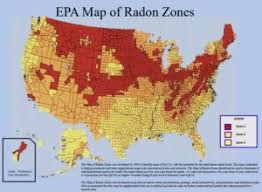
- Radon levels are a big concern in Maryland
- Leading cause of lung cancer death among non smokers
- Most clients add radon testing to their home inspection
Consider Testing if:
- House is in Maryland
PRICING
(done with home inspection)
$185
The EPA and the U.S. Surgeon General recommends that every real estate transaction include a radon test.
Radon is prevalent in Maryland and DC, and about 80% of our clients choose to get the radon tested during the home inspection.
It’s easy to test, and elevated levels are easily mitigated. There is a misconception that houses without basements or with walkout basements, don’t have elevated levels of radon. Many do.


Radon gas comes from the ground, so the risk exists in every style of house and the only way to know if a home’s levels are elevated is to test. Testing takes a minimum of two days and involves two visits to the subject property: one, to set up the continuous radon monitor. The second visit to pick it up, and you get the results on the same day as the pickup. It’s $185 while we are there performing a home inspection; and $225 when being done as a stand-alone test.
Radon is a naturally occurring radioactive gas which is the leading cause of lung-cancer deaths among non-smokers. It comes from deep within the Earth and can be found in low levels everywhere. Radon gas levels become something to mitigate only when they test above the actionable threshold of 4 pico/Curies per liter.

“Radon is a health hazard with a simple solution. Test. Fix. Save a life.” – United States Environmental Protection Agency
Radon is a naturally occurring colorless, odorless, tasteless radioactive gas that comes from the breakdown of uranium deep within the Earth. Homes with high levels can quickly and easily be fixed through well-established venting techniques, and the only way to know your home’s level is to test for it. The reason the level of radon level of exposure is important to know is because radon gas is the leading cause of lung cancer deaths among non-smokers. The EPA estimates that about 21,000 lives are lost every year due to radon-induced lung cancer. (And the European Union estimates that it loses about 20,000 people to radon-induced lung cancer each year). That is why past U.S. Surgeon General, Richard H. Carmona, urged everyone to test their homes using either a do-it-yourself test kit or by hiring someone to test for you.
There are two types of tests: long-term and short-term.
Long-term tests take three months or longer and give the most complete information. That’s because radon levels fluctuate from day to night and from season to season, so the longer you are able to let the test run, the better.
Short-term tests take about two days, giving you radon information for two days and two nights. The advantage to the short-term tests is that they, in most cases, fit into the time frame you have for inspections when buying a home.


There are two types of tests: long-term and short-term.
Long-term tests take three months or longer and give the most complete information. That’s because radon levels fluctuate from day to night and from season to season, so the longer you are able to let the test run, the better.
Short-term tests take about two days, giving you radon information for two days and two nights. The advantage to the short-term tests is that they, in most cases, fit into the time frame you have for inspections when buying a home.
Reading the information might have scared you enough that you are already googling where to buy test kits or how to find a professional tester. But, before you race to schedule a test or head to the local hardware store to pick up a test kit, there is one main question to consider: Do you really need to test?
You probably don’t need to test if you live on the fourth floor or higher in a condominium or apartment building. (If you live in the penthouse of a building with an elevator shaft, it is recommended that you DO test). You don’t need to test if your house is on stilts, (yay for not needing to test your waterfront home because it is off the ground to avoid flooding!)


While the Surgeon General recommends that all homes be tested, the homes that have the highest likelihood of having elevated radon levels are homes that touch dirt in some area of the home, and condominiums that are basement, first, second, or third floor units. If a home is on a slab, a crawl space, or a basement, testing is recommended.
Radon gas seeps into homes and other buildings through whatever parts of the structure are touching the soil. It is pulled into the home or building because the air pressure inside most structures is lower than the pressure in the surrounding soil. It is drawn in through cracks in floors, exposed soil, drains, sump-pump crocks, construction joints (where the floor and wall come together and mortar joints), and around loose-fitting pipes. When it is concentrated in home and above 4 picoCuries per liter and you breathe it long-term, you are at greater risk for lung cancer.
Radon is measured in picoCuries per liter (pCi/L). A pCi is a trillionth of a curie, which is a standard measure of radiation. A pCi/L is a unit of radioactivity corresponding to one decay every 27 seconds in a volume of one liter, or 0.037 decays per second in every liter of air. The actionable threshold for radon levels in the United States is 4 pCi/L and the World Health Organization recommends getting the radon level down below 2.7 pCi/L. That’s easy to do using the venting techniques I spoke about earlier.


Sub-slab depressurization (SSD) is usually the best way to lower radon levels in new and existing structures. The EPA defines the active SSD as “a system designed to achieve lower sub-slab air pressure relative to indoor air pressure by use of a fan-powered vent drawing air from beneath the slab” . This causes the radon gas to flow down rather than upward and reduces the potential of it getting into the house. In new construction, the SSD systems are usually passive – they are just the vents without fans. The system that is used in a structure with a crawl space operates just like the SSD and is called a Sub-membrane depressurization system.
Once the SSD is installed, the levels of radon begin to drop and the structure is ready for clearance testing within 2-3 days. Then every two years, you re-test the air to ensure that the system is still mitigating the radon levels sufficiently. (That can change due to changes in the Earth because those changes – think earthquakes – cause radon to be forced into new pathways to air as old pathways close up and new ones open.) Most of the fans and motors in the SSD last about ten years and then need to be replaced. The cost of initial installation is usually between $800 and $1,500 – depending on type of SSD system and installation location in the structure.























